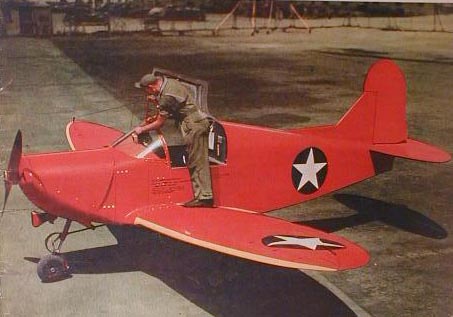Culver A-8/PQ-8/TDC Cadet
In August 1940, the U.S. Army Air Corps issued a requirement for a small radio-controlled aircraft for use as a target for anti-aircraft gunnery practice. Culver submitted a drone variant of their Cadet LFA sports plane, which was subsequently ordered by the USAAC in two versions, the A-8 powered by a Franklin O-200 piston engine, and the A-8A with a more powerful Lycoming O-290. In June 1941, the A-for-Aerial Target category was dropped because of possible confusion with the A-for-Attack series. The A-8 and A-8A became the PQ-8 and PQ-8A, respectively, and the prototype of the Cadet target was designated as XPQ-8. The PQ category designated targets with a provision for manned flight, and because PQ-8 was the first allocation in the series, numbers PQ-1 through -7 remained unassigned (see A-series for more background information).
The PQ-8 had a non-retractable tricycle landing gear, and could be flown by an on-board pilot for ferry or check-out flights. As an unmanned drone, it was visually tracked, and remotely controlled by a relatively simple radio-command system.
 |
| Photo: via Skylighters Website |
| PQ-8A |
Culver produced 200 each of the PQ-8 and PQ-8A targets. The U.S. Navy evaluated a single PQ-8 as XTDC-1 and a single PQ-8A as XTDC-2, followed by production of 200 TDC-2 drones. The production run of the Cadet was relatively limited, because it was soon superseded by the larger and more powerful PQ-14/TD2C series.
After the war, most surviving Cadet targets were sold as surplus and flown as small recreational planes. Source [2] says that a few PQ-8As remained in the U.S. Air Force inventory in 1948, when they were redesignated as Q-8A. However, several other sources say that there were no PQ-8s remaining in the inventory, when the USAF changed its designation system. In any case, the Q-8 designation was re-used in 1954, when the designations Q-8A/B/C were requested for allocation (the request was turned down, but for reasons which had nothing to do with the existence of a Q-8A designation in 1948).
Specifications
Note: Data given by several sources show slight variations. Figures given below may therefore be inaccurate!
Data for PQ-8A/TDC-2 (except where noted):
| Length | 5.38 m (17 ft 8 in) |
| Wingspan | 8.20 m (26 ft 11 in) |
| Height | 1.68 m (5 ft 6 in) |
| Weight | 590 kg (1300 lb) |
| Speed | 225 km/h (140 mph) PQ-8: 187 km/h (116 mph) |
| Ceiling | 5300 m (17500 ft) |
| Propulsion | Lycoming O-290 piston engine; 93 kW (125 hp) PQ-8: Franklin O-200 piston engine; 67 kW (90 hp) |
Main Sources
[1] Gordon Swanborough, Peter M. Bowers: "U.S. Military Aircraft since 1908", Putnam, 1989
[2] John M. Andrade: "U.S. Military Aircraft Designations and Serials, 1909 to 1979", Midland Counties, 1979
[3] James C. Fahey: "U.S. Army Aircraft 1908-1946", Ships and Aircraft, 1946
[4] James C. Fahey: "United States Air Force and United States Army Aircraft 1947-1956", Ships and Aircraft, 1956
[5] US Army Air Forces: "Army Aircraft Model Designations", 1946
Back to Directory of U.S. Military Rockets and Missiles, Appendix 1
Last Updated: 5 December 2006